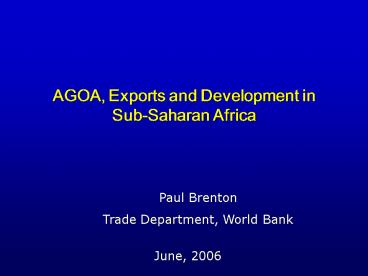AGOA, Exports and Development in SubSaharan Africa - PowerPoint PPT Presentation
1 / 10
Title:
AGOA, Exports and Development in SubSaharan Africa
Description:
... had limited impact confined to a few countries and driven mainly by apparel ... Non-restrictive rules for apparel must be made permanent ... – PowerPoint PPT presentation
Number of Views:207
Avg rating:3.0/5.0
Title: AGOA, Exports and Development in SubSaharan Africa
1
AGOA, Exports and Development in Sub-Saharan
Africa
Paul Brenton Trade Department, World Bank
June, 2006
2
AGOA at 5 Key issues
- AGOA provides improved (preferential) access to
the US market for African exporters - AGOA preferences have had limited impact
confined to a few countries and driven mainly by
apparel - A range of products are excluded including
textiles and sensitive agricultural products - Example, peanuts subject to a duty of 163.8
- Rules of origin are a key factor determining
impact - Non-restrictive rules for apparel must be made
permanent - For other products the 35 value-added
requirement should be reduced.
3
African exports to the US have increased, as have
exports to other regions
4
AGOA has been important, but has not been the
main driver of African export growth
5
For most countries the value of US trade
preferences is negligible
- For most African countries, agricultural products
and minerals remain the key exports typically
not subject to duties in US - Preference erosion an issue for few
6
Rules of origin are key in determining impact of
trade preferences
- ROO are an essential element of preferential
trade agreements to ensure that only
beneficiaries get better access (prevent trade
deflection) - But when ROO are used to achieve other objectives
they limit the benefits to developing countries - AGOA has provided for non-restrictive rules for
apparel, with substantial impact on trade
7
Less restrictive rules of origin have stimulated
trade
8
Restrictive ROO limit the impact of trade
preferences
- Undermine competitiveness by constraining access
to cheapest inputs - limit ability to integrate into global production
chains - burden falls particularly heavily upon small and
medium sized firms and upon firms in low income
countries - discriminate against small low income countries
where the scope for local sourcing is more
limited. - Undermine ability to exploit advantage of low
labour costs
9
AGOA can be improved
- Include all products
- Change approach to rules of origin
- Make third country fabric provision permanent
- Exporters should be able to choose between
satisfying either a 10 value-added requirement
or a change of tariff heading (at 6 digit level
of HS) - Would support expansion of exports of labour
intensive products - Would facilitate inclusion of African producers
in global production chains - No need for complicated cumulation provisions
10
AGOA, Trade Preferences and Development
- Effective trade preferences can provide a window
of opportunity to export whilst key barriers to
trade are addressed - Dealing with the barriers must be the priority
- aid for trade can support domestic reforms that
improve policy environments and help to address
infrastructure gaps that limit the capacity to
trade - Reducing trade costs supports access to all
markets and assists all sectors































